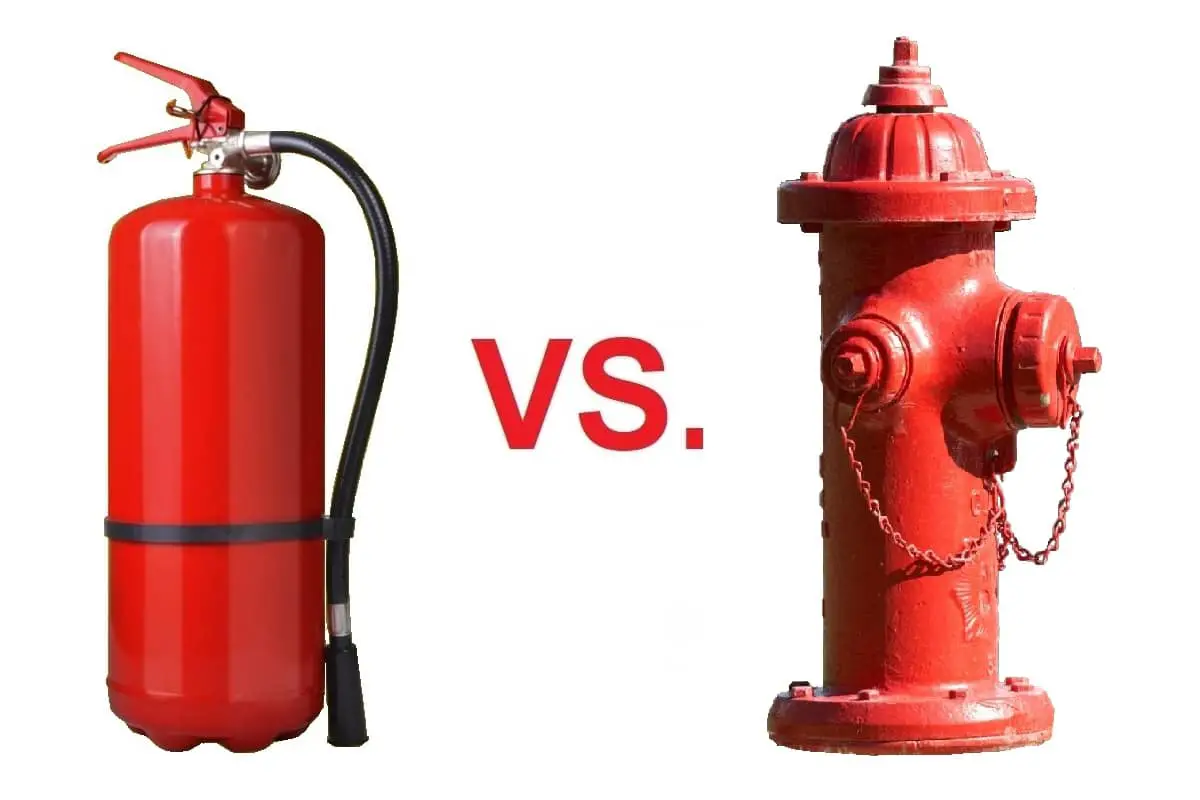Both fire extinguishers and fire hydrants are effective at putting out fires. But which one is best to use in an emergency? There are some major differences between the two, so read on to find out more.
How Much Water Comes Out Of a Fire Hydrant?
How many gallons per minute comes out of a fire hydrant?
Fire hydrant flow rate, in terms of gallons per minute (GPM) is determined by the type of fire hydrant. These each have unique colors.
NFPA 291 Fire Hydrant Classes
The NFPA provides color scheme guidelines for fire hydrant tops, caps, and nozzles.
Here is a general breakdown of fire hydrant colors and water flow rates:
1. Blue / light blue (Class AA) — 1500 GPM + (5700 L/min)
2. Green (Class A) — 1000–1499 GPM (3800–5699 L/min)
3. Orange (Class B) — 500–999 GPM (1900–3799 L/ min)
4. Red (Class C) — < 500 GPM (1900 L/ min)
This is a general overview of the different types of fire hydrants and GPM they produce. There are more color requirements associated with fire hydrant types and flow rates. See NFPA 291 for more info.
Each color fire hydrant produces a different gallons per minute (GPM). Large commercial or industrial fires require special fire hydrants.
Fire hydrants also have caps or bonnets that may be painted different colors to represent flow rate and water source they are connected to.

Fire hydrants spray drinking water that comes from the city’s water distribution system. This means that drinking fire hydrant water is not any better or worse than the water that comes out of your faucet at home.
Factors Affecting Fire Hydrant Flow Rates
Factors that affect the flow rate of fire hydrants are:
- The size of water pipes and main supplying the water.
- The primary, secondary, or distributor water infrastructure.
The water supplied to fire hydrants will be treated and maintained because it is city drinking water. However, the pipes may be worn out, damaged, or made to fit requirements that no longer exist. This means the water pressure may not be enough in that area to propel water out of a fire hydrant a far enough distance.
Fire Hydrant Vs. Fire Extinguisher Spray Distance
Fire hydrants that are not connected to a fire hose but are turned on sprayed can shoot water 1 – 25 feet depending on how far open it is.
A fire hydrant connected to a proper fire hose can propel water between 30 – 100 feet into the air depending on the water pressure. However, most firemen will rarely try to put a fire out that is more than 40 feet above their hose location.
A broken fire hydrant can shoot water 10-40 feet in height straight up.
Fire hydrants can basically spray water indefinitely. The city’s water supply should be more than adequate to provide the needed water, unless the underground pipes are damaged in the area.
A fire extinguisher can spray its contents between 5 – 20 feet in distance. They can spray their contents for between 10 – 30 seconds depending on their size.
Fire Hydrant Locations
Fire hydrants can be located on public or private lands. However, they will always be no closer than the street or outside land from the building or home. Buildings can also have fire inside them at certain critical locations.
Generally, commercial buildings are required to have a hydrant within “100 feet of the outside walls.
Residential buildings (including single family homes) are required by the NFPA to have fire hydrants no further than 600 feet away. If there are 2 or more fire hydrants in the area, they cannot be more than 800 feet from their center.
The NFPA provides requirements for fire hydrant installation. Fore more info, see NFPA 1 and 24.
A Fire Hydrant Wrench Is Required
To open a fire hydrant, the right wrench is needed. Fire hydrant wrenches exist and are often called ‘spanner’ wrenches. You can use the proper sized fire hydrant wrench or a large ordinary hand wrench (plumbers wrench). There may also be a key required to open the hydrant valve. More importantly, to open a fire hydrant, a city or local permit is required.
Which One Is Better: Fire Hydrant Or Fire Extinguisher?
For large fires that need the fire department to put out, fire extinguishers won’t put them out and a fire hydrant is crucial.
Which one is best also depends on the size of the fire and access to it (street, indoors, upstairs floors, etc.). Small indoor fires need a fire extinguisher to put out. Running a fire hose from the fire hydrant outside into a building to put out a small fire in one room is overkill and will create unnecessary property damage. Only if the flames engulf a portion or all of a building or home is a fire hydrant required.
A fire extinguisher does not require a special wrench to start it. Just pull the pin and squeeze the handle while pointing it in the right direction towards the base of the fire. Fire extinguishers are easily stored, don’t require permits to operate, and don’t require the fire department.
For more information, see our post Fire Extinguisher Vs. Water.

